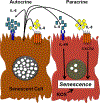Aging of the Liver: What This Means for Patients with HIV
- PMID: 27557619
- PMCID: PMC7002024
- DOI: 10.1007/s11904-016-0332-x
Aging of the Liver: What This Means for Patients with HIV
Abstract
As the HIV population continues to live longer as a result of antiretroviral therapy, liver-related mortality has become one of the leading causes of non-AIDS related death in this patient population. The liver possesses a remarkable regenerative capacity but undergoes complex biological changes in response to aging and inflammation that result in decreased cellular regeneration and a tipping of the scales towards fibrogenesis. Patients with HIV infection have serological evidence of ongoing inflammation, with elevations in some biomarkers persisting despite adequate virologic control. In addition, HIV-co-infected patients have markers of advanced age on liver biopsy and increased prevalence of fibrosis as compared to an age-matched HCV mono-infected cohort. In this review, we will discuss the biology of aging, age-related changes in the liver, and the relevant mechanisms by which HIV causes inflammation in the context of accelerated aging, fibrosis of the liver, and other viral co-infection.
Keywords: Aging; Co-infections; Fibrogenesis; HIV; Immunosenescence; Liver.
Figures

References
-
- Palella FJ Jr, Baker RK, Moorman AC, Chmiel JS, Wood KC, Brooks JT, et al. Mortality in the highly active antiretroviral ther- apy era: changing causes of death and disease in the HIV outpatient study. J Acquir Immune Defic Syndr. 2006;43(1):27–34. doi:10.1097/01.qai.0000233310.90484.16. - DOI - PubMed
-
- HIV Surveillance Report 2014. In: HIV surveillance report. CDC division of HIV/AIDS Prevention. 2015. http://www.cdc.gov/hiv/library/reports/surveillance/. Accessed 7/15/2016 26.
Publication types
MeSH terms
Substances
Grants and funding
LinkOut - more resources
Full Text Sources
Other Literature Sources
Medical
Research Materials

